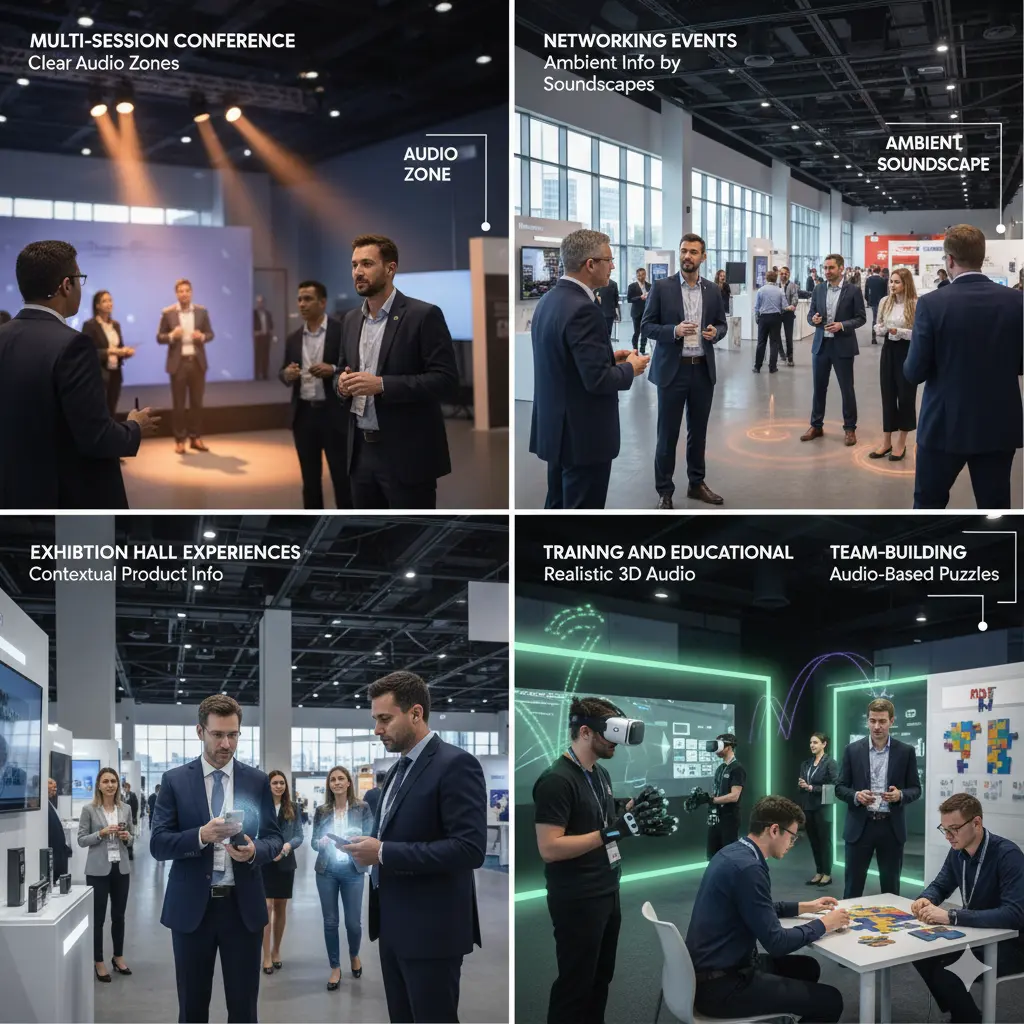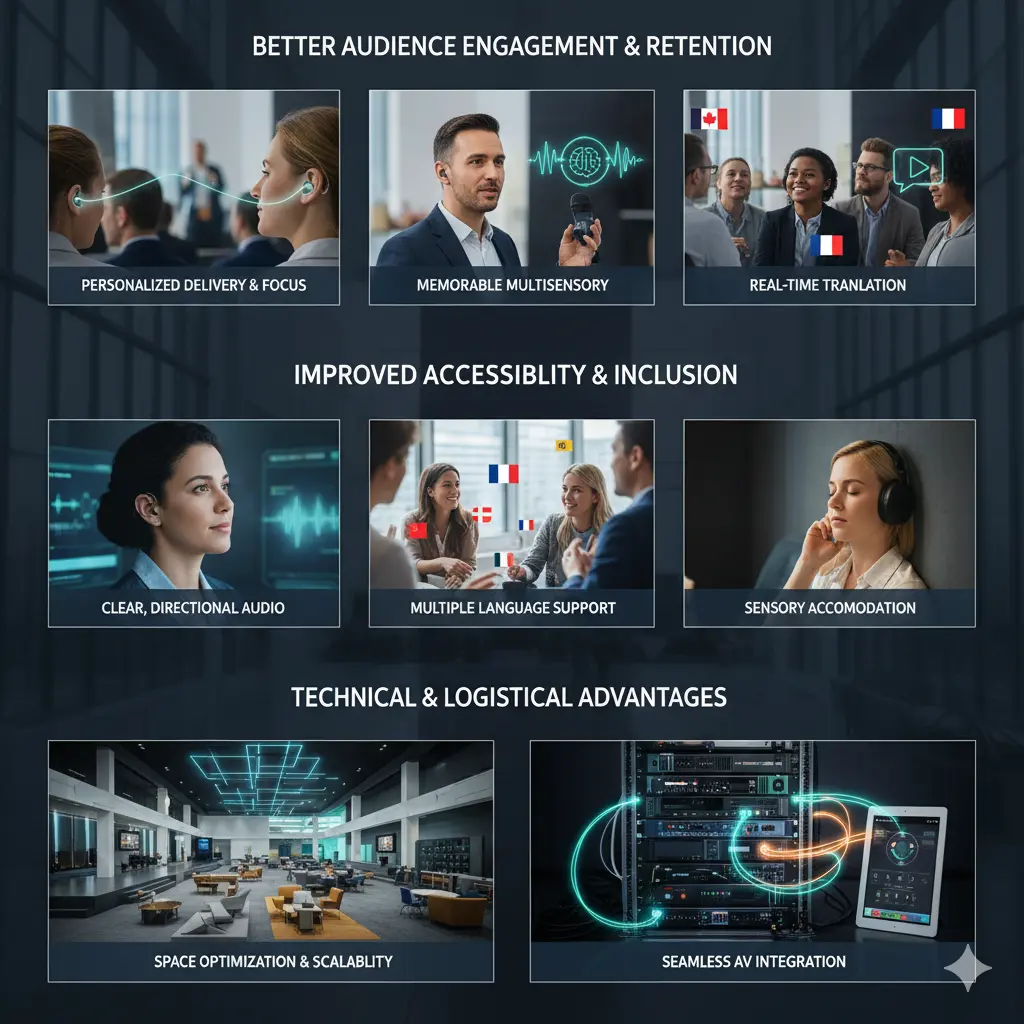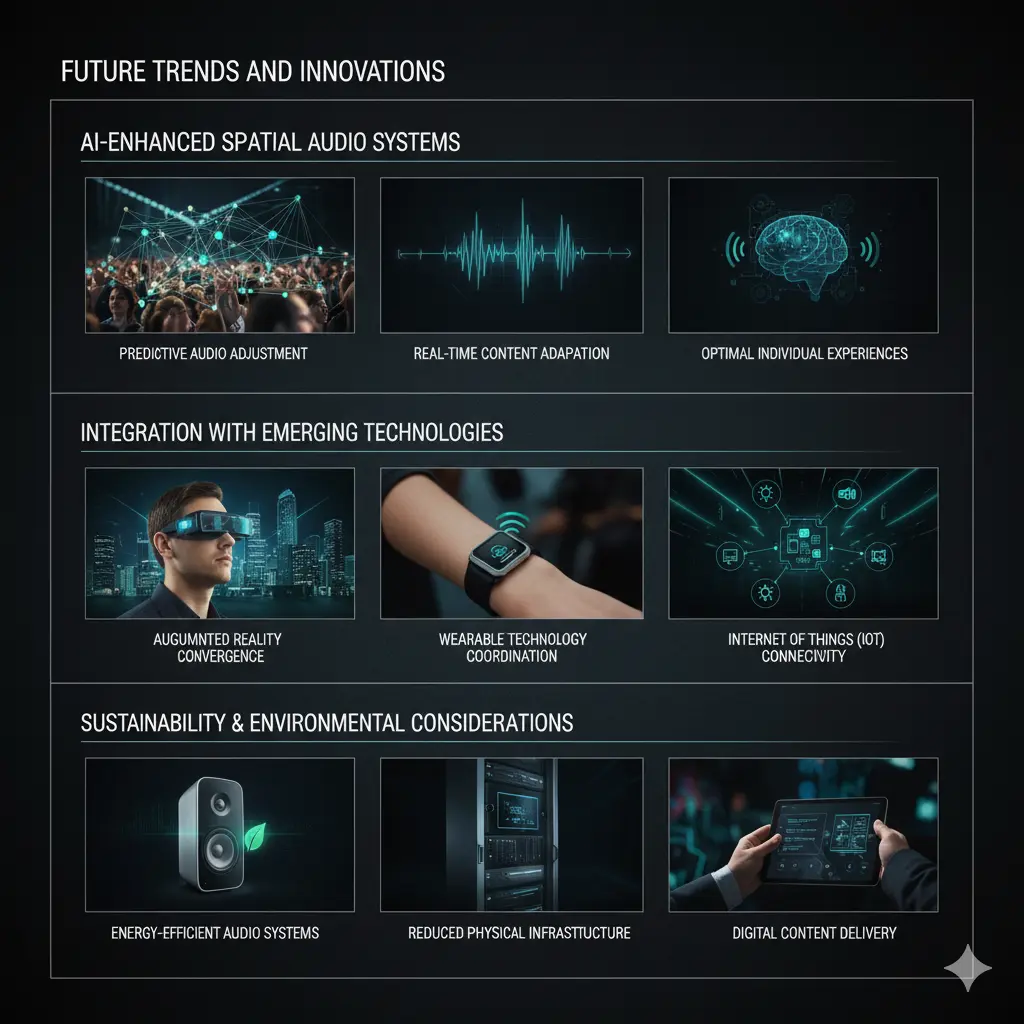
As corporate event experiences evolve beyond traditional presentations and networking sessions, spatial audio design is emerging as the game-changing technology that transforms how attendees engage with content and connect with brands. In Toronto’s competitive corporate event landscape, forward-thinking companies are discovering that three-dimensional sound environments create deeper emotional connections, enhance message retention, and deliver measurable business outcomes.
Spatial audio design goes far beyond conventional stereo sound systems, creating immersive sonic environments where every attendee experiences personalized, directional audio that adapts to their physical location and engagement level. For corporate event planners seeking to differentiate their experiences and maximize participant impact, understanding and implementing spatial audio represents a critical competitive advantage.
Understanding Spatial Audio Design Technology for Corporate Events
What is Spatial Audio Design?
Spatial audio design is an advanced sound technology that creates three-dimensional audio environments by precisely controlling how sound waves reach each listener’s ears. Unlike traditional stereo systems that broadcast the same audio to everyone, spatial audio systems deliver personalized sound experiences based on the listener’s position, movement, and interaction with the content.
This technology utilizes sophisticated algorithms, multiple strategically placed speakers, and real-time processing to create the illusion that sounds are originating from specific locations in three-dimensional space. For corporate events, this means presenters’ voices can appear to come from their exact location, product demonstrations can include realistic environmental sounds, and attendees can experience different audio content based on their proximity to various presentation zones.
The Science Behind Immersive Corporate Audio
Binaural sound production
It forms the foundation of effective spatial audio design. This approach mimics the natural way human ears process sound by accounting for the subtle timing and volume differences between what each ear hears. When properly implemented in corporate event settings, binaural audio creates remarkable realism that traditional sound systems cannot achieve.
The technology leverages Head-Related Transfer Functions (HRTFs) to calculate how sound waves interact with individual head shapes, ear geometry, and body positioning. While this might sound complex, the result is elegantly simple: attendees experience crystal-clear audio that feels natural and engaging, even in challenging acoustic environments like hotel ballrooms, convention centers, and outdoor venues.
Three-dimensional sound positioning
Three-dimensional sound positioning allows event producers to place audio elements precisely within the event space. A product demonstration can include sounds that appear to emanate from the actual product location, while background music creates ambient zones without interfering with presentation audio. This level of control transforms corporate events from passive listening experiences into active, immersive journeys.
Applications of Spatial Audio Design in Corporate Events
Product Launches and Demonstrations
Corporate product launches benefit tremendously from spatial audio design. Imagine unveiling a new automotive model where attendees hear the precise sound of the engine starting from the vehicle’s location, road noise that moves across the presentation space, and ambient sounds that transport the audience to different driving environments, all without overwhelming the presenter’s voice.
Technology companies launching software platforms can use spatial audio to create sonic interfaces where different features are associated with distinct audio signatures positioned throughout the demonstration area. This approach helps attendees understand complex product ecosystems through both visual and auditory spatial relationships.
Interactive demonstration zones become significantly more engaging when spatial audio guides attendees through different experience areas. Sales representatives can speak naturally without amplification, while product-specific audio content automatically adjusts based on visitor proximity and interest level.
Conference and Convention Enhancement

Multi-session conferences
Multi-session conferences present unique challenges for traditional audio systems. Spatial audio design solves the common problem of competing audio sources by creating distinct sonic zones where each presentation maintains clarity without interference from neighboring sessions.
Networking events
Networking events benefit from ambient audio zones that encourage conversation in designated areas while providing subtle background soundscapes that enhance the overall atmosphere. Rather than competing with conversation, properly designed spatial audio systems support natural interaction by reducing the cognitive load associated with filtering unwanted sound.
Exhibition hall experiences
Exhibition hall experiences can leverage spatial audio to provide contextual information as attendees move through different vendor areas. Product information, company presentations, and interactive content can be delivered through personal audio devices synchronized with attendee location and movement patterns.
Training and Educational Corporate Events
Corporate training sessions often struggle with audience engagement and information retention. Spatial audio design addresses these challenges by creating immersive learning environments where audio content reinforces visual presentations and hands-on activities.
Simulation-based training becomes remarkably realistic when spatial audio accurately reproduces the sound environments trainees will encounter in real-world situations. Emergency response training, customer service scenarios, and technical procedure instruction all benefit from accurate three-dimensional audio reproduction.
Team-building exercises can incorporate spatial audio challenges that require participants to navigate audio-based puzzles, coordinate responses to directional sound cues, and collaborate in ways that traditional presentation formats cannot achieve.
Benefits for Corporate Event Organizers

Better Audience Engagement and Retention
Research consistently demonstrates that multisensory experiences significantly improve information retention and emotional connection. Spatial audio design leverages this principle by creating memorable sonic associations with key messages, product features, and brand positioning.
Attention management becomes more sophisticated with spatial audio systems that can direct focus through strategic sound placement. Important announcements can appear to originate from specific locations, while background audio creates supportive ambiance without distraction.
Personalized experience delivery allows event organizers to provide different audio content to different attendee segments simultaneously. VIP guests might receive additional commentary, while international attendees access real-time translation services, all within the same physical space.
Improved Accessibility and Inclusion
Spatial audio technology dramatically improves event accessibility for attendees with varying hearing capabilities. By delivering clear, directional audio that reduces background noise interference, these systems help ensure that all participants can engage fully with event content.
Multiple language support becomes seamless when spatial audio systems deliver real-time translation services through personal audio devices. Attendees can switch between languages without disrupting others, while maintaining the natural flow of presentations and discussions.
Sensory accommodation options allow event organizers to provide alternative audio experiences for attendees with sensory processing differences, ensuring that corporate events are inclusive and welcoming for diverse professional communities.
Technical and Logistical Advantages
Space optimization represents a significant practical benefit of spatial audio design. Traditional sound systems require careful speaker placement and acoustic treatment that can limit venue layout options. Spatial audio systems provide greater flexibility in space utilization while delivering superior sound quality.
Event scalability becomes more manageable when audio systems can adapt to different group sizes, room configurations, and presentation formats without requiring extensive technical reconfiguration. This flexibility proves especially valuable for multi-day events with varying session types and audience sizes.
Integration capabilities with existing audiovisual equipment ensure that spatial audio enhancements complement rather than complicate current event production workflows. Professional AV companies can incorporate spatial audio elements without requiring complete system overhauls.
Implementation Considerations for Toronto Corporate Events
Venue Selection and Acoustic Planning
Toronto venue characteristics significantly influence spatial audio system design and implementation. Historic venues like the Royal York Hotel require different acoustic considerations than modern facilities like the Metro Toronto Convention Centre. Understanding these differences ensures optimal audio performance and attendee satisfaction.
Acoustic analysis should be conducted early in the event planning process to identify potential challenges and opportunities. Factors such as ceiling height, wall materials, ambient noise levels, and HVAC system sounds all impact spatial audio system performance and design requirements.
Hybrid event integration requires careful coordination between in-person spatial audio systems and virtual attendee audio delivery. Toronto’s position as a major business hub means many corporate events must seamlessly blend physical and digital participation options.
Technology Selection and Partnership
Professional AV integration is essential for successful spatial audio implementation. Toronto’s experienced audiovisual production companies understand the technical requirements, logistics coordination, and creative possibilities that spatial audio systems offer for different types of corporate events.
Equipment specifications must align with event objectives, venue characteristics, and budget constraints. Options range from personal headphone-based systems ideal for intimate presentations to large-scale speaker arrays suitable for convention-sized gatherings.
Creative content development requires collaboration between audio engineers, content creators, and event designers to ensure that spatial audio elements enhance rather than overwhelm core messages and objectives. The most successful implementations integrate audio design into the overall event narrative rather than treating it as a separate technical component.
Budget and ROI Considerations
Investment analysis for spatial audio implementation should consider both immediate event impact and long-term competitive advantages. While initial implementation costs may exceed traditional audio systems, the enhanced attendee engagement, improved accessibility, and unique differentiation often justify the investment.
Measurable benefits include increased attendee satisfaction scores, improved information retention metrics, enhanced social media engagement, and stronger post-event follow-up responses. These outcomes translate into tangible business value for corporate event sponsors and organizers.
Scalability planning allows organizations to implement spatial audio design gradually, starting with key presentations or demonstration areas and expanding based on attendee feedback and measured results. This approach manages costs while building internal expertise and confidence.
Future Trends and Innovations
AI-Enhanced Spatial Audio Systems
Artificial intelligence integration represents the next evolution in spatial audio design for corporate events. AI systems can analyze attendee movement patterns, engagement levels, and content preferences to automatically adjust audio delivery for optimal individual experiences.
Predictive audio adjustment capabilities will enable systems to anticipate attendee needs based on behavioral patterns, environmental changes, and presentation content. This proactive approach ensures consistent audio quality and engagement throughout complex event schedules.
Real-time content adaptation powered by AI will allow spatial audio systems to modify presentation audio based on audience response, ambient conditions, and technical performance metrics. This level of responsiveness creates truly dynamic event experiences that adapt to real-world conditions.
Integration with Emerging Technologies
Augmented reality convergence will create unified sensory experiences where spatial audio supports visual AR elements to create seamless digital overlay experiences for corporate events. This integration enables sophisticated product demonstrations, virtual venue tours, and interactive brand experiences.
Wearable technology coordination will enable more precise spatial audio delivery through smart badges, fitness trackers, and other personal devices that provide exact location and movement data. This precision enables more sophisticated audio targeting and personalization.
Internet of Things (IoT) connectivity will integrate spatial audio systems with environmental sensors, lighting controls, and other smart venue systems to create responsive environments that adapt to attendee presence, preferences, and engagement patterns.
Sustainability and Environmental Considerations
Energy-efficient audio systems are becoming increasingly important as corporate sustainability commitments influence event planning decisions. Modern spatial audio technologies often require less power than traditional large-speaker installations while delivering superior performance.
Reduced physical infrastructure requirements align with sustainable event practices by minimizing equipment transportation, installation complexity, and venue modification needs. This efficiency reduces the environmental footprint of corporate events while improving logistical flexibility.
Digital content delivery reduces the need for printed materials and physical handouts by enabling audio-based information sharing that attendees can access during and after events through personal devices.

Best Practices for Toronto Corporate Events
Pre-Event Planning and Testing
Comprehensive site surveys should evaluate acoustic conditions, ambient noise levels, and potential interference sources well in advance of event dates. Toronto’s urban environment presents unique challenges including traffic noise, construction activities, and neighboring event conflicts.
Technology rehearsals ensure that spatial audio systems integrate smoothly with presentation content, speaker requirements, and attendee interaction elements. These rehearsals should include backup scenarios and contingency planning for technical challenges.
Attendee communication helps set appropriate expectations and provides necessary information about personal device requirements, accessibility options, and optimal positioning for spatial audio experiences.
During-Event Management
Real-time monitoring systems
Real-time monitoring systems should track audio performance, attendee engagement, and technical system status throughout events. This monitoring enables immediate adjustments and ensures consistent experience quality for all participants.
Technical support availability
Technical support availability is crucial for addressing unexpected challenges, assisting attendees with personal device integration, and making real-time adjustments based on changing conditions or requirements.
Feedback collection
Feedback collection during events provides valuable insights for immediate improvements and future event planning. Simple survey tools and observation protocols help identify successful elements and areas for enhancement.
Post-Event Analysis and Improvement
Performance metrics analysis should evaluate both technical system performance and attendee experience outcomes. Key metrics include audio quality ratings, engagement levels, content retention, and overall satisfaction scores.
Content effectiveness assessment helps identify which spatial audio elements contributed most significantly to event objectives and attendee satisfaction. This analysis guides future investment and implementation decisions.
Technology evolution planning ensures that spatial audio implementations remain current with advancing capabilities and changing attendee expectations. Regular system updates and capability enhancements maintain competitive advantage and experience quality.
Embracing the Future of Corporate Event Audio
Spatial audio design represents a transformative opportunity for Toronto’s corporate event community to create more engaging, accessible, and memorable professional experiences. As traditional presentation formats struggle to maintain audience attention in an increasingly digital world, three-dimensional audio environments offer a compelling solution that enhances rather than replaces existing event elements.
The most successful corporate events of the future will seamlessly blend visual, auditory, and interactive elements to create holistic experiences that resonate with diverse professional audiences. Binaural sound production and three-dimensional audio positioning technologies provide the foundation for these enhanced experiences while addressing practical challenges including venue limitations, audience accessibility, and content delivery complexity.
For Toronto businesses seeking to differentiate their corporate events and maximize participant engagement, spatial audio design offers measurable benefits that justify investment and implementation complexity. The technology’s ability to create personalized, immersive experiences while improving accessibility and information retention aligns perfectly with evolving corporate event objectives and attendee expectations.
As spatial audio technology continues to advance and integrate with other emerging technologies, early adopters will establish competitive advantages that extend beyond individual events to encompass broader brand differentiation and professional community leadership. The question is not whether spatial audio will become standard in corporate event production, but how quickly forward-thinking organizations will embrace its transformative potential.
Ready to revolutionize your corporate event experiences with cutting-edge spatial audio design? Contact Toronto’s leading audiovisual production specialists to discover how three-dimensional sound environments can transform your next business gathering into an unforgettable, results-driven experience.

Comments are closed.